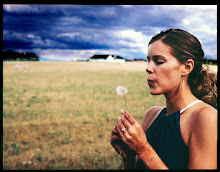



Since Usman started writing the pieces for his current show, thinkTank: American Ethnic, I've been thinking about an art exhibit I saw in college at the Seattle Art Museum. It was titled Only Skin Deep: Changing Visions of the America Self and was a collaboration between the San Diego Museum of Art (SDMA) and the Museum of Photographic Arts (MoPA). It is still one of the best exhibits I have ever seen and I still look at the book (by the same title) that was produced in conjunction with the exhibit. I don't believe the exhibit is still up at the SDMA, but I highly recommend the book.
The exhibit and book look at prints, stills, digital images, etc. from the mid 19th century to the present and examine how the photographers intended, or, more interestingly, not intended, to comment on race. Similar to American Ethnic, the exhibition explored how photography specifically has shaped our ideas about nation, race, ethnicity and ourselves. Photography is very much a part of American culture and we all consume the ideas that are presented to us on TV, billboards, in magazines, or those we take to represent ourselves. Race is going to be presented in these images we see and will communicate ideas that we can think critically about or just accept.
As humans, we naturally want to classify and categorize the information we receive to make sense of our world. This is very helpful for our understanding of people and the world, but can be dangerous if we don't think about how or why we are categorizing certain ideas in certain "files." When we are trying to learn new information, we need some prior knowledge (or a file, if you will) to put this information into. If we don't have that "file," we may put it into the wrong "file" or create a new one and label it inaccurately. I can think of a couple of examples...
In college, I was working on creating a brochure for an office and I wanted to use images to make it more attractive. I was given a cd of approved "education" pictures that included a variety of models who were posing as teachers and students. Almost all of the teachers were white and female. While there are many white, female teachers in our country, this cd of pictures did not include an accurate representation of the teachers in our country. If someone doesn't work in schools or doesn't know a male teacher or teacher of color, they might automatically equate "teacher" with "white female." Maybe this seems harmless, but then you think about those people creating textbooks, worksheets, TV shows, and thus, more images of teachers as being white females and you can see how stereotypes can be perpetuated. Maybe young students are then seeing these images and when they are thinking about what they want to be when they grow up, they might not think of being a teacher if they do not think that they fit into that category.
Another example, that happened in graduate school, really surprised and angered me. All of us school social workers had to come up with different social work groups that we might run in a school. Someone was presenting a group on teaching appropriate school behavior (or something similar) and passed out some worksheets for us to use with our students. One worksheet looked like a coloring sheet of kids playing on a playground and the students was supposed to circle the kids that were playing nicely. To my surprise, every single girl was playing nicely and every single boy was cheating, hitting, or doing something bad...Talk about promoting stereotypes of girls being "sugar and spice and everything nice" and boys "just being boys." While students may not consciously pick up on these stereotypes, when they get these images and ideas enough (and believe me, they do) they learn their roles and sometimes live up to them. The other worksheet this classmate passed out had a bunch of pictures of children. I don't remember the purpose of the worksheet anymore because I was appalled that there was one Asian student who had glasses and a book (aka the "model minority") and one Black student who was male and holding a basketball (aka "the athlete"). I don't think I need to explain this to you.... and yes, when young people AND adults see these images, they do learn from them.
I had another incident the other day with someone at my gym, who has probably learned stereotypes from images he has seen in the news. I mentioned that I wanted to travel to Pakistan to meet my husband's parents. When he heard this, he immediately started talking about Arabs and how they are "aggressive people" and Pakistan is very dangerous, but he quickly added that he is sure my husband is a very nice guy (there always has to be the exception to the rule, huh!?) First off, Pakistanis are South Asian, not Arab, but where do you think he got this view of Arabs when he has only lived in the United States and South America!? I am assuming, like American Ethnic presents, that he has only seen images of Arabs as terrorists or bad guys and clips about bombings and deaths in the news.
Anyways...this has gotten to be a long blog. Basically, I want to get the point across that art (in this case, photos) can easily perpetuate stereotypes and inaccurate ideas about race and ethnicity. The exhibit, Only Skin Deep, consciously explores how photographers have played a role in shaping American identity....a very influential role indeed.
Here are a few photos from the exhibit...you'll have to check out the book to see more! :)
1. Eleanora Antinova in Pocahontas, from the "Recollections of my Life with Diaghilev" - by Eleanor Antin
2. Klanswoman - by Andres Serrano
3. Harlem - by Aaron Siskind
4. Migrant Mother - by Dorthea Lange

